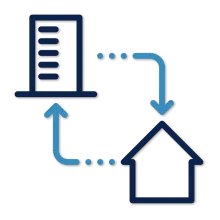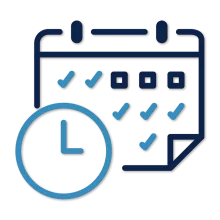
Embracing evolving workforce trends positions the University of Arizona as a great workplace and ensures our continued competitiveness in the current labor market.
Please use this page to support flexibility while ensuring we continue to pursue our educational mission successfully. Visit the Flexible Work Initiative page for more information.
Employees State that Flexible Work Increases Their:
Data from the April 2022 staff and supervisor surveys. Full report (PDF)
What is Flexible Work?
Flexible work refers to arrangements that alter an employee’s:
- Work location outside of a university building, office, or workplace (Flexible Space).
- Schedule outside of a traditional Monday-Friday, 8 a.m.-5 p.m. (Flexible Schedule).
A flexible work arrangement can include either or both types of flexibility.
Types of Flexible Work
Hybrid Work Week
Flexible Space
Summer Remote Periods
Flexible Space
Fully Remote
Flexible Space
Flexible Schedule
Flexible Schedule
Compressed Work Week
Flexible Schedule
Core Business Hours
Flexible Schedule
Guidelines and Templates
Before initiating a flexible work arrangement staff and supervisors should discuss and consider the following:
- Work hours and procedures for documenting productivity.
- Expectations for remaining in contact with coworkers during work hours.
- Responsibility and process for setting up remote meetings.
- Documented agreements.
Please review the following guidance. Contact your HR Generalist Team for assistance.
Flexible Work Program Guidelines
These guidelines explain the types of flexible work arrangements that may be available to certain employees and the process by which such an arrangement is developed and implemented.
Out-of-State Work Arrangement Guidelines
The complexities and costs of complying with state and local laws and tax requirements are increasing. Requests for out-of-state work arrangements require leadership review and approval and must meet specific institutional guidelines.
Flexible Work Agreement Template
This agreement template is a suggested guide to help units and departments document flexible work arrangements. It is provided as an MS Word file to allow customization, as needed.
Supervisors Decision Guidance
This planning template from University Initiatives includes suggested considerations to help supervisors plan, implement, and monitor their team's arrangements.
Tip: Don't forget to obtain and consider your department's/unit’s Continuity of Operations Plan (COOP) and emergency communication process.
Additional Resources
Remote Work Expenses
Financial Services offers guidelines to help you ensure that all necessary expenses related to flexible and remote work are appropriate and reasonable.
Training and Courses in EDGE Learning
Research from the 2022 Flexible Work Initiative showed training areas that can help lead to more successful flexible work arrangements. With the help of the EDGE Learning project team, we have curated suggested courses to address those needs.
Flexible Work: Case Studies
The 2022 Flexible Work Initiative project team researched how successful flexible work arrangement programs are being implemented across the university.
Frequently Asked Questions
General Questions
No. If you have non-exempt (hourly) employees, the 9/80 schedule will not be an option for them due to payroll regulations. Please consult with your HR Generalist Team for guidance.
Maybe. Regulations may exist that complicate compressed work weeks for out-of-state employees who are non-exempt (hourly). Please consult with your HR Generalist Team for guidance.
Out-of-state work is not within the scope of the flexible work arrangements. To account for the complexities and costs of complying with state and local laws and tax requirements, and to ensure we remain committed to our Arizona community and land-grant mission, requests for out-of-state work arrangements require leadership review and approval and must meet specific institutional guidelines.
For international requests, please visit our International Employment page.
For domestic requests, please visit our Out-of-State Domestic Work Arrangement Guidelines page.
Yes. Decisions about flexible work arrangements must be guided by the responsibilities of individual positions, workforce characteristics and the needs of a unit. However, the process to evaluate unit needs and employee requests must be consistent and equitable.
Supervisors can review the Supervisors Planning Template (.docx) for suggested questions and considerations to help ensure a consistent decision process.
Workstations, Supplies, and Equipment
Yes. To efficiently use on-campus workspace and grant flexibility requests from employees, units may create shared workspaces as a condition of a hybrid schedule.
No. Although hybrid arrangements may be made, employees will be responsible for supplying the necessary office equipment for the second workspace. Employee equipment needs and access must be considered when evaluating flexible work arrangements.
Yes. Employees may keep university-issued office supplies and equipment at an off-site location if it is in line with the flexible work agreement and is not detrimental to the requirements of the position and the needs of the department/unit.
Please use the Certification Statement For Off-Campus Location Use of Equipment (PDF) to document any university equipment taken to a building or site not owned or leased by the university.






